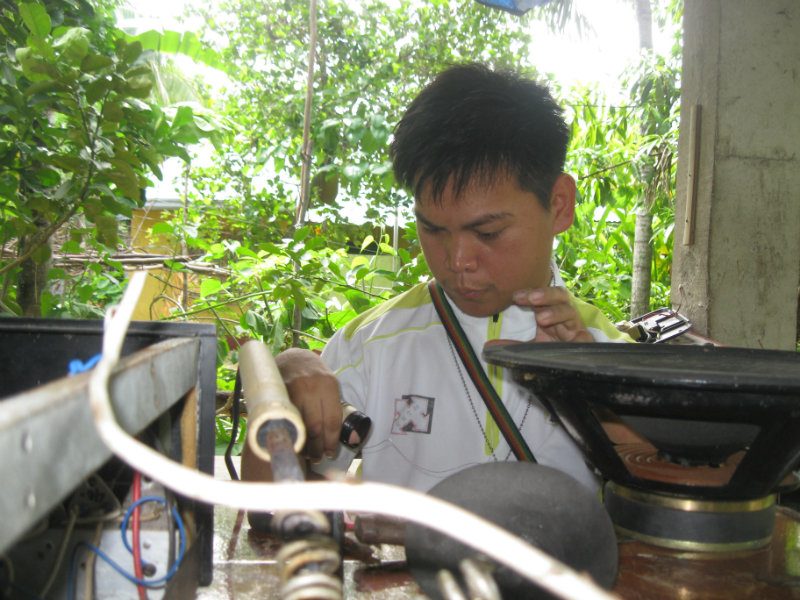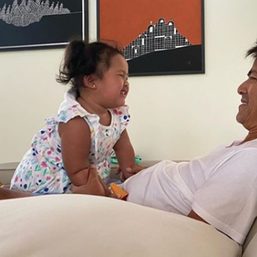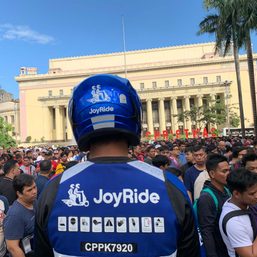SUMMARY
This is AI generated summarization, which may have errors. For context, always refer to the full article.

CEBU, Philippines – Gerald Ybañez walked out of his room, passing by a wheelchair just outside the door.
He beamed as he walked, his hands against the wall, then on the wooden sofa in the living room, and towards the front door. He approached his working table crowded with wires and tools in the veranda, completing the 5-meter walk from his room.
Ybañez, 24, has cerebral palsy. That day, he was ready to immerse himself in work that requires meticulous attention to detail – he was repairing a speaker.
His physical movement today is very different from a decade ago when Ybañez could only sit and crawl. His legs and feet then were stiff.
When he was 9 months old, his mother, Lita, detected that her son was different from other children his age. “We had no idea what was his condition. I only sought the help of a quack doctor,” Lita said.
Before her son turned 10, Lita relied on the albularyo’s advice, which was to subject Gerald to palina or using incense to cast away evil spirits. She said she stopped when her son turned 10 years old, since there was no improvement in his condition.
Believing in education
At age 6, Ybañez started attending classes in day care. He had no wheelchair so Lita to carry him on her back to school, a 5-kilometer distance each way.
When Ybañez graduated from grade school, Lita decided not to enroll him in high school. “I was frightened with the thought that Gerald’s days in high school would only be marred with unpleasant encounters, with bullying, with discrimination.” she said.
Ybañez cried when he learned about this because he had dreams, and he would “continue to dream until the last thread of his breath.” While Lita had worries, her son was even more terrified as given his situation, what would be his future without enough education? He was serious in getting an education.
Ybañez eventually persuaded his mother to enrolled him in high school, which was 9 kilometers away from their house. This time, however, he owned a wheelchair.
Lita was proven wrong. Ybañez had many friends in school. He was nurtured by a caring school community where teachers and classmates supported him.
Gerald’s first step
When Ybañez was 14 years old, he got a visit from NORFIL, a non-profit foundation that provides help to children and youth with disabilities through community-based rehabilitation. They wanted to help him.
Gerald underwent a medical check-up and doctors confirmed that he has cerebral palsy.
NORFIL provided him with home-based therapies and exercises. Ybañez’s stiff leg and feet muscles were loosened because Lita, fueled by a mother’s love, zealously did the exercises and therapy on her son every day for two years.
Ybañez took his first step at the age of 16. “That first step brought me massive joy, literally. Right then, I wanted another step, another step, and another step,” recalls Gerald, perhaps without realizing that such first step was a great leap towards living his life to its full potential.
More steps soon followed after. Ybañez graduated from high school. For him, it was not enough. A year after graduation, he enrolled himself in the technical vocational program at the Area Vocational Rehabilitation Center of the Department of Social Welfare and Development (DSWD). He studied electronics.
Ybañez is now an electronics technician repairing cellphones, rice cookers, electric fans, speakers, amplifiers, and DVDs. He earns P1,000 to P4,000 a week. He has a bank account for his savings and a fair share of his earnings goes to his mother.
Ybañez can now walk with a home-made walker. He intends to raise a family one day. He is courting someone, a 22-year-old girl who knows about his disability.
According to the 2010 Philippine census, 1.57% or 1.4 million persons of the country’s 92.1 million population have disabilities. Of this number, one could lose count of the number of persons with disabilities who have live with hopelessness and other challenges, day after day.
Ybañez hopes that his boldness to dream and his willingness to live would resonate with others like him. “Our disability, our marginality must not deter us from leading our lives to our fullest potential,” he said.
“We must blot out ‘dis’ in the word disability, for the truest disability we could have is the inability to believe that we all have abilities we could use in achieving our dreams,” Ybañez added. – Rappler.com
Glenn Tek-ing Muñez is the Training Officer of NORFIL Foundation, Inc.
Add a comment
How does this make you feel?





There are no comments yet. Add your comment to start the conversation.